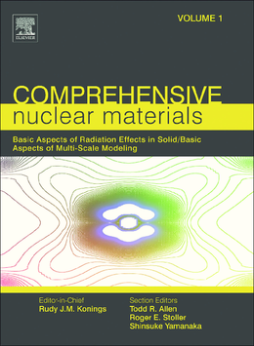
BOOK
Comprehensive Nuclear Materials
Rudy Konings | Todd R Allen | Roger E Stoller | Shinsuke Yamanaka
(2011)
Additional Information
Book Details
Abstract
Comprehensive Nuclear Materials discusses the major classes of materials suitable for usage in nuclear fission, fusion reactors and high power accelerators, and for diverse functions in fuels, cladding, moderator and control materials, structural, functional, and waste materials. The work addresses the full panorama of contemporary international research in nuclear materials, from Actinides to Zirconium alloys, from the worlds' leading scientists and engineers.
- Critically reviews the major classes and functions of materials, supporting the selection, assessment, validation and engineering of materials in extreme nuclear environment
- Fully integrated with F-elements.net, a proprietary database containing useful cross-referenced property data on the lanthanides and actinides
- Details contemporary developments in numerical simulation, modelling, experimentation, and computational analysis, for effective implementation in labs and plants
From the Foreword: Nuclear materials denotes a field of great breadth and depth, whose topics address applications and facilities that depend upon nuclear reactions. The major topics within the field are devoted to the materials science and engineering surrounding fission and fusion reactions in energy conversion reactors. Most of the rest of the field is formed of the closely related materials science needed for the effects of energetic particles on the targets and other radiation areas of charged particle accelerators and plasma devices. A more complete but also more cumbersome descriptor, thus, would be “the science and engineering of materials for fission reactors, fusion reactors, and closely related topics. In these areas the very existence of such technologies turns upon our capabilities to understand the physical behavior of materials. Performance of facilities and components to the demanding limits required are dictated by the capabilities of materials to withstand unique and aggressive environments. The unifying concept that runs through all aspects is the effect of radiation on materials. In this way the main feature is somewhat analogous to the unifying concept of elevated temperature in that part of materials science and engineering termed “high-temperature materials.
Nuclear materials came into existence in the 1950s, and began to grow as an internationally recognized field of endeavor late in that decade. The beginning in this field has been attributed to presentations and discussions that occurred at the First and Second International Conferences on the Peaceful Uses of Atomic Energy, held in Geneva in 1955 and 1958. Journal of Nuclear Materials, which is the home journal for this area of materials science, was founded in 1959. The development of nuclear materials science and engineering took place in the same rapid growth time period as the parent field of materials science and engineering. And similarly to the parent field, nuclear materials draws together the formerly separate disciplines of metallurgy, solid-state physics, ceramics, and materials chemistry that were early devoted to nuclear applications. The small priesthood of first researchers in half a dozen countries has now grown to a cohort of thousands, whose home institutions are anchored in more than 40 nations.
The prodigious work, Comprehensive Nuclear Materials, captures the essence and the extensive scope of the field. It provides authoritative chapters that review the full range of endeavor. In the present day of glance and click “reading of short snippets from the Internet, this is an old-fashioned book in the best sense of the word, which will be available in both electronic and printed form. All of the main segments of the field are covered, as well as most of the specialized areas and subtopics. With well over 100 chapters, the reader finds thorough coverage on topics ranging from fundamentals of atom movements after displacement by energetic particles, to testing and engineering analysis methods of large components. All the materials classes that have main application in nuclear technologies are visited, and the most important of them are covered in exhaustive fashion. Authors of the chapters are practitioners who are at the highest level of achievement and knowledge in their respective areas. Many of these authors not only have lived through a substantial part of the history sketched above, but they themselves are the architects. Without those represented here in the author list, the field would certainly be a weaker reflection of itself. It is no small feat that so many of my distinguished colleagues could have been persuaded to join this collective endeavor and to make the real sacrifices entailed in such time consuming work. I congratulate the Editor, Rudy Konings, and the associate Editors, Roger Stoller, Todd Allen and Shinsuke Yamanaka. This book will be an important asset to young researchers entering the field as well as a valuable resource to workers engaged in the enterprise at present. --Dr. Louis K. Mansur, Oak Ridge, Tennessee, USA, May 2011
